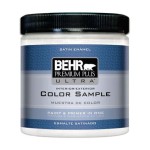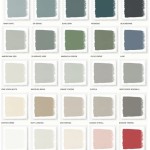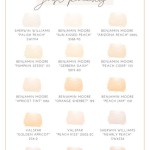Choosing Paint Colors for a Living Room: A Comprehensive Guide
Selecting the right paint colors for a living room is a crucial step in creating a cohesive and inviting space. The living room often serves as the central hub of a home, a place for relaxation, entertainment, and family gatherings. Therefore, the color palette should reflect the desired atmosphere and complement the existing décor. This article will explore various aspects of choosing paint colors, considering factors such as room size, lighting, and personal preferences, providing a framework for making informed decisions.
The impact of color psychology on mood and behavior is a significant consideration. Different colors evoke distinct emotions and associations. Understanding these psychological effects can guide the selection process, ensuring that the chosen colors contribute to a positive and harmonious living environment. Furthermore, the interplay between color and light significantly influences the perceived appearance of a room. Natural and artificial light sources can alter the intensity and hue of paint colors, underscoring the importance of testing samples under various lighting conditions before committing to a final decision.
Understanding Color Theory
Color theory provides a foundational understanding of how colors interact and relate to one another. The color wheel, a visual representation of colors arranged according to their chromatic relationship, is a valuable tool for exploring color combinations. Primary colors (red, yellow, and blue) are the basis for all other colors. Secondary colors (green, orange, and violet) are created by mixing two primary colors. Tertiary colors are formed by mixing a primary color with an adjacent secondary color.
Harmonious color schemes, built upon the principles of color theory, create visually pleasing and balanced spaces. Complementary color schemes use colors opposite each other on the color wheel, such as red and green or blue and orange. These schemes create high contrast and can be visually stimulating. Analogous color schemes utilize colors that are adjacent to each other on the color wheel, such as blue, blue-green, and green. These schemes provide a sense of harmony and tranquility. Triadic color schemes employ three colors that are evenly spaced on the color wheel, such as red, yellow, and blue. These schemes offer a balanced vibrancy.
Monochromatic color schemes use variations of a single color, incorporating different shades, tints, and tones. This creates a sophisticated and cohesive look. Shades are created by adding black to a color, making it darker. Tints are created by adding white to a color, making it lighter. Tones are created by adding gray to a color, which dulls its vibrancy.
Neutral color schemes, consisting of shades of white, gray, beige, and brown, provide a versatile and timeless backdrop. These schemes can be paired with pops of color through accessories and artwork, allowing for flexibility in design. The undertones of neutral colors, which can be warm (red, yellow, or orange) or cool (blue, green, or violet), should be considered to ensure compatibility with other elements in the room.
Factors Influencing Color Selection
Several factors beyond color theory influence the optimal paint color choices for a living room. These factors include the size and shape of the room, the amount of natural light, the existing décor, and the overall desired atmosphere.
Room size is a crucial consideration. Lighter colors tend to make a room appear larger and more open, while darker colors can make a room feel smaller and more intimate. In a small living room, it is generally advisable to use lighter, brighter colors to maximize the sense of space. Conversely, in a large living room, darker colors can be used to create a more cozy and inviting atmosphere. However, even in a large room, using dark colors on all walls can make the space feel overwhelming. Consider using darker colors on accent walls or in specific areas to add depth and visual interest.
The amount of natural light a room receives significantly impacts the way colors appear. Rooms with ample natural light can handle bolder and more saturated colors, while rooms with limited natural light may benefit from lighter and brighter colors to maximize illumination. Northern-facing rooms tend to have cooler, indirect light, which can emphasize the coolness of blue and gray tones. Southern-facing rooms receive warmer, more direct light, which can enhance the warmth of yellow and orange tones. Eastern-facing rooms receive bright morning light but cooler afternoon light, while western-facing rooms receive softer morning light and warmer afternoon light. Understanding these variations in natural light is essential for selecting colors that will look their best throughout the day.
Existing décor, including furniture, flooring, and textiles, plays a vital role in the color selection process. Paint colors should complement and harmonize with the existing elements in the room. Consider the color palette of the furniture and accessories and choose paint colors that either match or contrast in a pleasing way. For instance, if the living room features a sofa in a neutral color like beige or gray, a wider range of paint colors can be used. However, if the sofa is a bold color like red or blue, the paint color should be carefully chosen to avoid clashing. Flooring materials also influence color choices. Warm-toned wood floors pair well with warm paint colors, while cool-toned stone floors complement cool paint colors.
The desired atmosphere of the living room is another important consideration. If the goal is to create a relaxing and calming space, soft and muted colors like blues, greens, and grays are suitable choices. These colors evoke feelings of tranquility and serenity. If the goal is to create a more energetic and stimulating space, bolder and more vibrant colors like reds, oranges, and yellows can be used. However, it is essential to use these colors sparingly, as they can be overwhelming if used excessively. Consider using them as accent colors or in smaller areas of the room.
Popular Living Room Paint Color Options
Numerous paint color options are suitable for living rooms, each offering unique aesthetic qualities and contributing to different atmospheres. Some consistently popular choices include neutrals, blues, greens, grays, and whites, although specific shades and undertones will vary based on individual preferences and design considerations.
Neutral colors, particularly shades of white, beige, and gray, are a classic choice for living rooms. White walls provide a clean and minimalist backdrop that allows furniture and accessories to take center stage. White can also make a room feel larger and brighter. Beige is a warm and inviting neutral color that creates a cozy and comfortable atmosphere. Gray is a versatile neutral color that can be either warm or cool, depending on its undertones. Light gray walls create a sophisticated and modern look, while darker gray walls can add depth and drama to a space.
Blue is a popular color choice for living rooms, known for its calming and serene qualities. Light blue walls can create a relaxing and airy atmosphere, while darker blue walls can add a sense of sophistication and drama. Navy blue is a classic choice that pairs well with white trim and accents. Teal is a vibrant and modern blue-green hue that adds a touch of personality to a space. When selecting blue paint, consider the undertones. Blues with green undertones tend to feel more natural and calming, while blues with violet undertones can feel more sophisticated and luxurious.
Green is another popular color choice for living rooms, evoking feelings of nature and tranquility. Light green walls can create a fresh and airy atmosphere, while darker green walls can add a sense of earthiness and warmth. Olive green is a sophisticated and versatile hue that complements a variety of decorating styles. Mint green is a light and refreshing color that is perfect for creating a cheerful and inviting space. As with blue, the undertones are important. Greens with yellow undertones tend to feel warmer and more vibrant, while greens with blue undertones feel cooler and more calming.
Gray is a versatile and sophisticated color that has become increasingly popular in recent years. Light gray walls create a modern and minimalist look, while darker gray walls can add depth and drama to a space. Greige, a blend of gray and beige, is a warm and inviting neutral that complements a wide range of decorating styles. When selecting gray paint, it is essential to consider the undertones. Grays with blue undertones tend to feel cooler and more modern, while grays with yellow undertones feel warmer and more traditional.
While white is often considered a neutral backdrop, different shades of white can create vastly different effects. Warm whites, with undertones of yellow or cream, create a cozy and inviting atmosphere. Cool whites, with undertones of blue or gray, create a clean and modern look. Off-white shades, such as ivory and eggshell, offer a softer and more nuanced alternative to pure white. Ultimately, the choice of white paint will depend on the desired aesthetic and the existing elements in the room.
The Best Paint Colors For Living Rooms In 2024

7 Popular Paint Colors For The Living Room Full Circle Realty
.jpg?strip=all)
Two New Living Room Paint Colors Dream Green Diy

Living Room Paint Colors The Home Depot

8 Vibrant Living Room Paint Color Ideas Dumpsters Com

30 Living Room Paint Colors Inspiration For An Inviting Space Benjamin Moore

How To Use Bold Paint Colors In Your Living Room

Living Room Paint Color Ideas And Tips To Match The Right

How To Pick A Living Room Paint Color Wow 1 Day Painting

30 Living Room Paint Colors Inspiration For An Inviting Space Benjamin Moore
Related Posts








